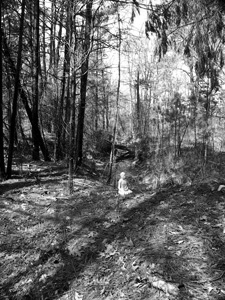Breathing
Breathing is the place where the mind meets the body, the place where the conscious and unconscious minds meet. It is a place of deep interdependency and exchange between "us" and "the universe." Focusing on the continuous repetition of breathing in and out has long been practiced in many types of meditation, not just in Zen.
 In zazen, both the inhalation and exhalation are through the nose. The mouth remains closed. The breath should have a sense of going down into and coming out from inside the lower abdomen a few inches below the navel, an area known in Japanese as the hara. Proper Zen breathing is said to be abdominal, deep, rhythmic, relaxed, and natural. However, it certainly may not be or feel that way at the beginning of one's practice. Rather than to try to force your body into breathing in some predetermined "natural" or "right" way, it is better, at least initially, just to become acquainted with the sensations you feel in your body as you breathe. Get to know your body by paying attention to the way you are breathing, without trying to change anything. Concentrate on the internal physical sensations in your chest and abdomen as the breath moves in and out. Relax any tensions associated with the breath and gently nudge your body toward breathing more deeply and fully, but don't force it. Becoming more and more intimate with your breath is a lifelong process, a continuous koan.
In zazen, both the inhalation and exhalation are through the nose. The mouth remains closed. The breath should have a sense of going down into and coming out from inside the lower abdomen a few inches below the navel, an area known in Japanese as the hara. Proper Zen breathing is said to be abdominal, deep, rhythmic, relaxed, and natural. However, it certainly may not be or feel that way at the beginning of one's practice. Rather than to try to force your body into breathing in some predetermined "natural" or "right" way, it is better, at least initially, just to become acquainted with the sensations you feel in your body as you breathe. Get to know your body by paying attention to the way you are breathing, without trying to change anything. Concentrate on the internal physical sensations in your chest and abdomen as the breath moves in and out. Relax any tensions associated with the breath and gently nudge your body toward breathing more deeply and fully, but don't force it. Becoming more and more intimate with your breath is a lifelong process, a continuous koan.
Regarding breathing, Deshimaru said: "Control your breathing. But in fact to control your breathing does not mean to control your breathing. Breathing controls itself. Breathing is subjective. Breathing is not done by oneself; it is not done by the consciousness, nor by the ego. Breathing is done unconsciously by the body. It can be said that our breathing, during zazen, is the action of nature, of the cosmos. So the reason for this breathing is its rhythm. It is the rhythm of the fundamental cosmic power."
